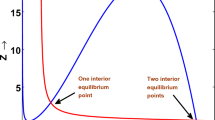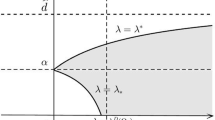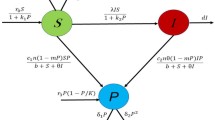Abstract
If two microbial populations compete for a single resource in a homogeneous environment with time invariant inputs they cannot coexist indefinitely if the resource competed for is not renewed by biological activity within the system. Mathematical studies have shown that in a predator-prey system, where the resource (prey) is self-renewing, the two competitors (predators) can coexist in a limit cycle. This suggests that if the resource competed for is renewed by biological activity within the system coexistence can occur in any microbial system provided that it exhibits the same features as, but without being, a predator-prey one. A food chain involving commensalism, competition and amensalism is presented here. Two subcases are considered. It is only when maintenance effects are taken into account that coexistence, in limit cycles, can occur for this system. Limit cycle solutions for the system are demonstrated with the help of computer simulations. Some necessary conditions for coexistence are presented, as are some speculations regarding the possible physical explanations of the results.
Similar content being viewed by others
Literature
Agrawal, P., C. Lee, H. C. Lim and D. Ramkrishna. 1982. “Theoretical Investigations of Dynamic Behavior of Isothermal Continuous Stirred Tank Biological Reactors.”Chem. Engng Sci. 37, 453–462.
Aiba, S. and M. Shoda. 1969. “Reassessment of Product Inhibition in Alcohol Fermentation.”J. Ferment. Technol., Osaka,47, 790–794.
Amundson, N. R. 1966.Mathematical Methods in Chemical Engineering: Matrices and Their Applications. Englewood Cliffs, NJ: Prentice-Hall.
Aris, R. and A. E. Humphrey. 1977. “Dynamics of a Chemostat in which Two Organisms Compete for a Common Substrate.”Biotechnol. Bioengng 19, 1375–1386.
Baltzis, B. C. 1983. Ph.D. Thesis, University of Minnesota, in preparation.
Butler, G. J. and P. Waltman. 1981. “Bifurcation from a Limit Cycle in a Two Predator-One Prey Ecosystem Modeled on a Chemostat.”J. math. Biol. 12, 295–310.
Butler, G. J., S. B. Hsu and P. Waltman. 1982. “Coexistence of Competing Predators in a Chemostat.” Preprint.
Chao, C. C. and P. J. Reilly. 1972. “Symbiotic Growth ofAcetobacter syboxydans andSaccharomyces Carlsbergensis in a Chemostat.”Biotechnol. Bioengng 14, 75–92.
Fredrickson, A. G. 1983. “Interactions of Microbial Populations in Mixed Culture Situations.” ACS Symposium Series, No. 207, pp. 201–227.
— and G. Stephanopoulos. 1981. “Microbial Competition.”Science 213, 972–979.
— and H. M. Tsuchiya. 1977. “Microbial Kinetics and Dynamics.” InChemical Reactor Theory, a Review, Ed. L. Lapidus and N. R. Amundson, Ch. 7, pp. 405–483. Englewood Cliffs, NJ: Prentice-Hall.
Hardin, G. 1960. “The Competitive Exclusion Principle.”Science 131, 1292–1297.
Herbert, D. 1958. “Continuous Culture of Microorganisms; some Theoretical Aspects.” InContinuous Cultivation of Microorganisms, a Symposium, Ed. I. Málek, pp. 45–52. Prague: Publishing House of the Czechoslovak Academy of Sciences.
Hsu, S. B., S. P. Hubbell and P. Waltman. 1978. “Competing Predators.”SIAM J. appl. Math. 35, 617–625.
Jost, J. L., J. F. Drake, H. M. Tsuchiya and A. G. Fredrickson. 1973. “Microbial Food Chains and Food Webs.”J. theor. Biol. 41, 461–484.
Koch, A. L. 1974. “Competitive Coexistence of Two Predators Utilizing the Same Prey Under Constant Environmental Conditions.”J. theor. Biol. 44, 387–395.
Luedeking, R. and E. L. Piret, 1959. “A Kinetic Study of the Lactic Acid Fermentation. Batch Process at Controlled pH.”J. biochem. microbiol. Technol. Engng,1, 393–412.
Megee, R. D., J. F. Drake, A. G. Fredickson and H. M. Tsuchiya. 1972. “Studies in International Symbiosis.Saccharomyces cerevisiae andLactobacillus casei.”Can. J. Microbiol. 18, 1733–1742.
Monod, J. 1942.Recherches sur la Croissance des Cultures Bactériennes. Paris: Herman et Cie.
Reilly, P. J. 1974. “Stability of Commensalistic Systems.”Biotechnol. Bioengng 16, 1373–1392.
Smith, H. L. 1981. “Competitive Coexistence in an Oscillating Chemostat.”SIAM J. appl. Math. 40, 498–522.
—1982. “The Interaction of Steady State and Hopf Bifurcations in a Two-Predator-One-Prey Competition Model.”SIAM J. appl. Math. 42, 27–43.
Stephanopoulos, G. N., R. Aris and A. G. Fredrickson. 1979a. “A Stochastic Analysis of the Growth of Competing Microbial Populations in a Continuous Biochemical Reactor.”Math. Biosci. 45, 99–135.
—, A. G. Fredrickson and R. Aris. 1979b. “The Growth of Competing Microbial Populations in a CSTR with Periodically Varying Inputs.”A.I.Ch.E. Jl 25, 863–872.
Waltman, P., S. P. Hubbell and S. B. Hsu. 1980. “Theoretical and Experimental Investigations of Microbial Competition in Continuous Culture.” InModeling and Differential Equations in Biology, Ed. T. A. Burton, pp. 107–152. New York: Marcel Dekker.
Note added in proof
Armstrong, R. A. and R. McGehee. 1980. “Competitive Exclusion.”Am. Nat. 115, 151–170.
Author information
Authors and Affiliations
Rights and permissions
About this article
Cite this article
Baltzis, B.C., Fredrickson, A.G. Coexistence of two microbial populations competing for a renewable resource in a non-predator-prey system. Bltn Mathcal Biology 46, 155–174 (1984). https://doi.org/10.1007/BF02463728
Received:
Revised:
Issue Date:
DOI: https://doi.org/10.1007/BF02463728




